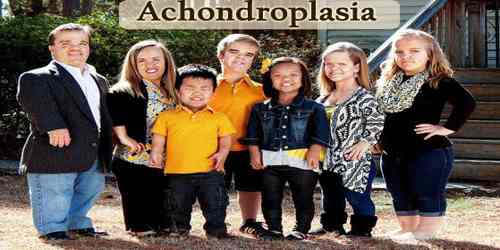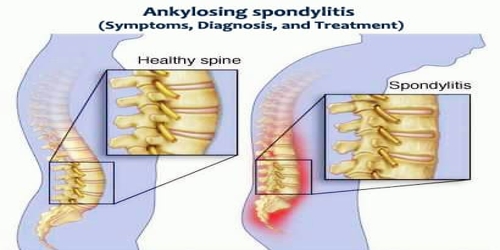Achondroplasia
Definition
Achondroplasia is a skeletal disorder, characterized by failure of normal conversion of cartilage into bone that begins during fetal life and results in dwarfism. The word achondroplasia literally means “without cartilage formation.” Cartilage is a tough but flexible tissue that makes up much of the skeleton during early development. It occurs as a sporadic mutation in about 80% of cases (associated with advanced paternal age) or it may be inherited as an autosomal dominant genetic disorder. The disorder occurs in approximately 1 in 25,000 live births, according to Columbia University Medical Center (CUMC). It’s equally common in males and females. It is caused by mutation in the fibroblast growth factor receptor-3 gene (FGFR3), which is located on chromosome 4 in chromosome band 4p16.3.
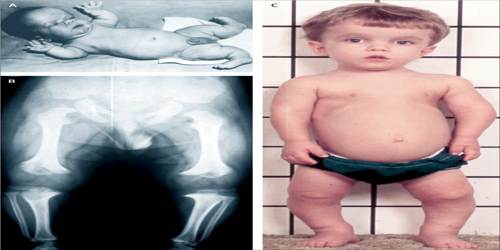
Aside from short arms and legs, the fingers are short and the ring and middle fingers diverge giving the hand a trident (three- pronged) appearance. There is a typically large head with prominence of the forehead (frontal bossing), underdevelopment (hypoplasia) of the midface with cheekbones that lack prominence, and a low nasal bridge with narrow nasal passages. The brain is normal and intelligence is entirely normal in achondroplasia. However, the complications of achondroplasia can impinge on the brain and the spinal cord.
People with achondroplasia have short stature, with an average adult height of 131 centimeters (52 inches) for males and 123 centimeters (48 inches) for females. Achondroplastic adults are known to be as short as 62.8 cm (24.7 in). Achondroplasia can be diagnosed before birth by molecular means. The limited number of changes in the FGF3 gene responsible for achondroplasia and the ease with which they can be detected provide the basis for a simple method for prenatal diagnosis.
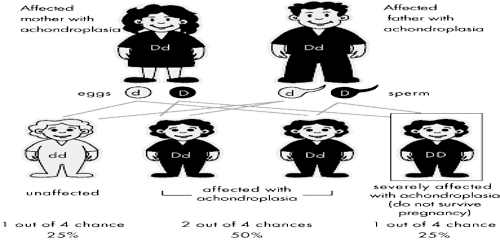
Causes, Sign and Symptoms of Achondroplasia
Achondroplasia is caused by a mutation in fibroblast growth factor receptor 3 (FGFR3). The FGFR3 gene instructs our body to make a protein necessary for bone growth and maintenance. Mutations in the FGFR3 gene cause the protein to be overactive. This interferes with normal skeletal development. The effect is genetically dominant, with one mutant copy of the FGFR3 gene being sufficient to cause achondroplasia, while two copies of the mutant gene are invariably fatal (recessive lethal) before or shortly after birth, which is also known as a lethal allele. A person with achondroplasia thus has a 50% chance of passing dwarfism to each of their offspring. People with achondroplasia can be born to parents that do not have the condition due to spontaneous mutation.
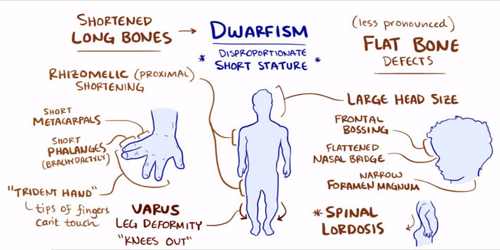
Achondroplasia is similar to another skeletal disorder called hypochondroplasia, but the features of achondroplasia tend to be more severe. People with achondroplasia generally have normal intelligence levels. Their symptoms are physical, not mental.
- Due to poor bone development, the bones are shortened, particularly in the thigh and upper arms, a condition known as rhizomelia.
- The thigh and upper arms are more affected because they have longer bones and larger growth plates (regions of the bones where growth occurs).
- The lower legs and forearms are affected to a lesser degree because their growth plates are smaller.
- The hands and feet are also short with unusual separation between the third and fourth digits.
- Affected individuals reach a maximum height of 120 cm (four feet).
- The torso usually develops to its proper size but the head may be larger than normal with a prominent forehead and flat nose.
- Affected children have delayed development and often take longer to learn to sit, crawl and walk than their unaffected peers. They may also develop a curved spine and bowed legs.
- Adults can suffer from back and leg pain. Abnormal development of the head may result in hearing loss and infections.
- In the worst cases, the abnormal structure of the skull and vertebrae can cause compression of the spinal cord, resulting in paralysis and breathing difficulties.
The average height for adults with achondroplasia is 4 feet, 4 inches for males and 4 feet, 1 inch for females, according to The Children’s Hospital of Philadelphia (CHOP). It’s rare for an adult with achondroplasia to reach a height of 5 feet.
Diagnosis and Treatments of Achondroplasia
Achondroplasia is generally diagnosed by bone measurement during physical examination or after X-ray. Prenatal diagnosis is recommended if one or both of the parents are already affected. In the majority of cases, achondroplasia occurs spontaneously through mutations in the sperm or egg. The risk of death in infancy is increased due to the likelihood of compression of the spinal cord with or without upper airway obstruction.

There is no known cure for achondroplasia even though the cause of the mutation in the growth factor receptor has been found. Growth hormones can help people with achondroplasia to achieve moderate growth in some children. Surgery is a treatment option in some cases to increase leg length by up to 30 cm, prevent spinal compression, or correct bowed legs. In some people with achondroplasia it may be necessary to drain fluid from the head to:
- relieve pressure on the brain
- test for hydrocephalus, a condition where spinal fluid builds up inside the skull.
Achondroplasia is one of 19 congenital conditions with similar presentations, such as osteogenesis imperfecta, multiple epiphyseal dysplasia tarda, achondrogenesis, osteopetrosis, and thanatophoric dysplasia.
Reference:
